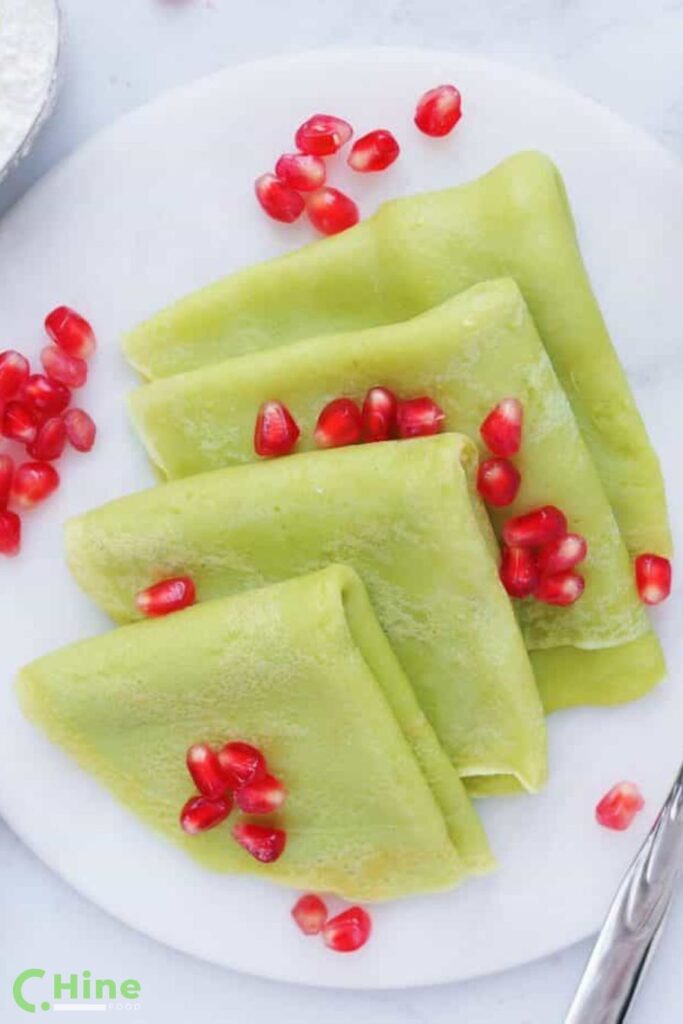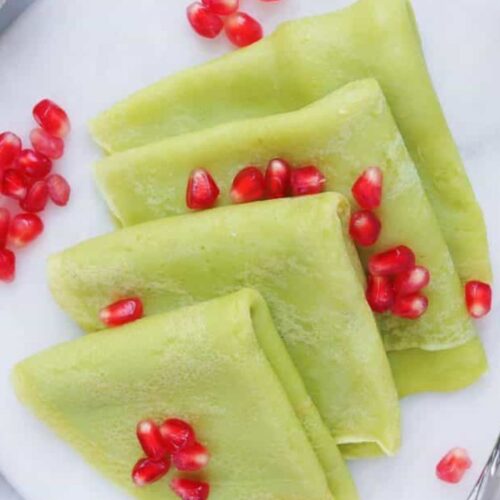
Indonesian Pandan Crepes are a delightful treat that brings a taste of Southeast Asia right to your kitchen. Originating from the tropical islands of Indonesia, these vibrant crepes are infused with the aromatic essence of pandan leaves, which offer a unique flavor profile that’s both nutty and floral. Traditionally known as Kuih Dada Dadar Gulung, these rolled delights are a staple in Indonesian, Malaysian, and Singaporean street food, often enjoyed for breakfast or as a sweet snack.
Ingredients & Substitutes
To make these delightful Indonesian Pandan Crepes, I carefully select each ingredient for maximum flavor and texture. Here’s what you need:
For the Crepes
- 1 cup all-purpose flour
Substitute: Use rice flour for a gluten-free option. - 1 1/4 cups coconut milk
Substitute: Almond milk can work in a pinch but will alter the flavor slightly. - 2 large eggs
Substitute: Flax eggs (1 tablespoon ground flaxseed mixed with 2.5 tablespoons water per egg) for a vegan alternative. - 1/4 cup sugar
Substitute: Coconut sugar for a more caramel-like flavor. - 1 teaspoon salt
No substitute necessary; it enhances the taste. - 1/2 cup pandan juice (freshly blended and strained)
Substitute: If pandan leaves are unavailable, you can use a few drops of pandan extract for similar flavor.
For the Filling
- 1 cup grated coconut (fresh or desiccated)
Substitute: Unsweetened shredded coconut if fresh is not available. - 1/2 cup palm sugar (chopped)
Substitute: Brown sugar for sweetness but it has a different flavor profile. - 1/2 teaspoon salt
No substitute necessary; it balances the sweetness. - Sesame seeds
Substitute: Chopped nuts for added texture.
Having these ingredients prepared and ready allows me to create the perfect crepes with that iconic green color and irresistible pandan flavor.
Instructions
- Prepare the Batter
In a mixing bowl, combine 1 cup of all-purpose flour and 1 tablespoon of sugar. Whisk them together until well blended. Next, add 1 cup of coconut milk, 2 eggs, a pinch of salt, and 1/4 cup of pandan juice. Use a whisk to mix everything until the batter is smooth and free of lumps. Let the batter rest for about 30 minutes. This allows the flour to hydrate, resulting in tender crepes. - Cook the Crepes
Heat a non-stick skillet or crepe pan over medium heat. Lightly grease the surface with a little oil or cooking spray. Once hot, pour approximately 1/4 cup of the batter into the center of the skillet. Immediately tilt the pan in a circular motion to spread the batter evenly into a thin layer. Cook for about 2 minutes or until the edges start to lift and the bottom turns lightly golden. Carefully flip the crepe using a spatula and cook for an additional 1 minute. Transfer the cooked crepe to a plate and cover it to keep warm. Repeat this process with the remaining batter, stacking the crepes as you go. - Prepare the Filling
In a bowl, combine 1 cup of grated coconut and 1/2 cup of palm sugar. Mix them until the coconut is evenly coated with the sugar, allowing the flavors to meld. If you prefer a sweeter filling, adjust the amount of palm sugar to taste. - Assemble the Crepes
Take a cooked crepe and place it on a clean surface. Add approximately 2 tablespoons of the coconut filling along one edge of the crepe. Gently roll the crepe away from you, enclosing the filling. You can fold the sides inward for better presentation. Repeat this process with each crepe until all are filled. - Serve and Enjoy
Serve the pandan crepes warm or at room temperature. They can be enjoyed as is or drizzled with additional palm sugar syrup for enhanced sweetness.

Expert Tips
To achieve the best Indonesian Pandan Crepes, I’ve gathered some expert tips that can elevate your cooking experience and ensure delightful results.
- Use Fresh Pandan Leaves: Whenever possible, use fresh pandan leaves to make your pandan juice. The vibrant color and fragrance from fresh leaves will enhance the flavor of your crepes significantly.
- Rest the Batter: Allow the crepe batter to rest for at least 30 minutes. This resting period helps the flour absorb the liquids, resulting in a smoother texture and more tender crepes.
- Non-Stick Skillet: A non-stick skillet is essential for cooking the crepes. This prevents sticking and makes flipping them much easier. Ensure your skillet is preheated and lightly greased with oil before pouring in the batter.
- Thin Layers: Pour a small amount of batter to create thin crepes. This ensures they cook through without becoming chewy. Adjust the batter amount according to your skillet size for uniform thickness.
- Adjust Sweetness: Taste the filling mixture before using it. Depending on your preference for sweetness, you can add more palm sugar or adjust the grated coconut quantity for texture.
- Serving Suggestions: Serve the crepes warm or at room temperature. For an added touch, drizzle palm sugar syrup on top, or garnish with toasted sesame seeds for a nutty flavor.
- Storage: If you have leftovers, store them in an airtight container in the refrigerator. Reheat gently in a skillet before serving to maintain their delightful taste and texture.
- Creative Fillings: Feel free to experiment with fillings. Shredded chocolate, fresh fruit, or even a mix of both grated coconut and chocolate can provide a delicious twist to the classic recipe.
FAQ
What Are Pandan Leaves and Where Can I Find Them?
Pandan leaves are long green leaves from the pandanus plant, widely used in Southeast Asian cuisine for their distinct sweet and floral aroma. I find them at Asian grocery stores or sometimes in the fresh produce section of larger supermarkets. If unavailable, pandan extract can be used as a substitute.
Can I Make These Crepes Gluten-Free?
Absolutely! To make gluten-free Indonesian pandan crepes, I suggest using a gluten-free all-purpose flour blend in place of regular all-purpose flour. Ensure the blend contains a binding agent like xanthan gum for the best texture.
How Should I Store Leftover Crepes?
I recommend storing leftover crepes in an airtight container in the refrigerator. They can last for about three days. To reheat, simply steam them lightly or warm them in a skillet over low heat.
Can I Use Other Fillings Besides Grated Coconut and Palm Sugar?
Certainly! The beauty of these crepes lies in their versatility. I often enjoy experimenting with various fillings, such as shredded chocolate, fresh fruits like banana or mango, or even sweetened cream cheese for a twist.
How Do I Adjust the Sweetness in the Filling?
I prefer to taste the filling as I prepare it. I add more palm sugar based on my sweet preference. For a healthier option, I sometimes use honey or maple syrup to sweeten the grated coconut.
Why Is It Important to Rest the Batter?
Resting the batter for about 30 minutes allows the flour to fully hydrate and the gluten to relax, which results in tender and flavorful crepes. I always notice a significant difference in texture when I take this step seriously.
Can I Freeze Pandan Crepes?
Yes, freezing pandan crepes is a great option for meal prep. I separate each crepe with parchment paper before placing them in a freezer-safe bag. They can be frozen for up to a month. To enjoy, thaw in the refrigerator and reheat.
What Type of Skillet Is Best for Cooking Crepes?
I find that using a non-stick skillet works best for making crepes. It ensures easy flipping and reduces the amount of oil needed, leading to a healthier outcome. A well-seasoned cast-iron skillet also does the job beautifully.

Delicious Indonesian Pandan Crepes Recipe: A Sweet Coconut Delight
Ingredients
For the Crepes:
- 1 cup all-purpose flour
- 1 1/2 cups coconut milk
- 3 large eggs
- 2 tablespoons sugar
- 1/4 teaspoon salt
- 1/2 cup pandan juice (freshly extracted or store-bought)
For the Filling:
- 1 cup grated coconut (fresh or desiccated)
- 1/2 cup palm sugar (grated or chopped)
- 2 tablespoons water
Instructions
- Make the Crepe Batter: In a mixing bowl, combine the all-purpose flour, coconut milk, eggs, sugar, salt, and pandan juice. Whisk until the mixture is smooth. Cover and let it rest for 30 minutes to achieve a tender texture.
- Prepare the Filling: In a small saucepan, combine the grated coconut, palm sugar, and water. Cook over low heat, stirring continuously for about 5 minutes until the mixture is slightly sticky and well combined. Remove from heat and set aside.
- Cook the Crepes: Heat a non-stick skillet over medium heat. Lightly grease it with oil if needed. Pour about 1/4 cup of the batter into the center of the skillet. Swirl the skillet to spread the batter into a thin circle. Cook for about 2 minutes until the edges lift and the surface is set. Flip the crepe and cook for an additional 1 minute. Stack the cooked crepes on a plate and cover with a cloth to keep warm.
- Assemble the Crepes: Take one crepe and place a generous tablespoon of the coconut filling in the center. Fold the edges over to encase the filling and gently roll the crepe. Repeat with the remaining crepes and filling.
- Serve: Arrange the filled crepes on a serving platter. Drizzle with palm sugar syrup and sprinkle with toasted sesame seeds if desired. Enjoy your Indonesian Pandan Crepes warm or at room temperature.
Nutrition
Trying out Indonesian Pandan Crepes is an experience I highly recommend. The vibrant green color and unique flavor bring a delightful twist to any meal. Whether you enjoy them for breakfast or as a snack they’re sure to impress your family and friends.
I love how versatile these crepes can be with various fillings. Experimenting with different flavors keeps things exciting. Don’t hesitate to share your own variations or tips in the comments.
I can’t wait to hear how your cooking adventures turn out. Happy cooking and enjoy every bite of this delicious treat!


Leave a Reply